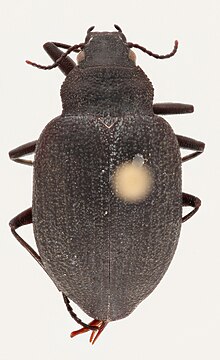Amphizoa is a genus of aquatic beetles in the suborder Adephaga, placed in its own monogeneric family, Amphizoidae.[1] There are five known species of Amphizoa, three in western North America and two in the eastern Palearctic.[2] They are sometimes referred to by the common name troutstream beetles.[2]
| Amphizoa | |
|---|---|

| |
| Amphizoa insolens LeConte 1853 | |
| Scientific classification | |
| Domain: | Eukaryota |
| Kingdom: | Animalia |
| Phylum: | Arthropoda |
| Class: | Insecta |
| Order: | Coleoptera |
| Suborder: | Adephaga |
| Family: | Amphizoidae LeConte, 1853 |
| Genus: | Amphizoa LeConte, 1853 |
| Species | |
| |
Description
editTroutstream beetles have a characteristic appearance. They are relatively large, oval, slightly convex, dull black to piceus. Body length ranges between 11–16 mm (0.43–0.63 in). The head is broad with a quadrate shape and small round eyes. The antenna is filiform, rather short with 11 segments. The pronotum is significantly narrower than the elytra and with lateral margins slightly crenulated; the prosternal processes are broad and flat, rounded to truncate at the apex; the elytra are vaguely striate and have a series of short spines of unknown function.[3] The legs are not well adapted for swimming, and lack long swimming setae. The hind coxae extend to the lateral margin of the abdomen and the tarsal formula is 5-5-5.[3][4]
Known species of Amphizoa
editThe genus Amphizoa contains the following known species:[1]
Biology
editTroutstream beetles can be found in streams and rivers in mountain regions of China, North Korea and western North America. Streams are often cold and medium to fast flowing, and the beetles can be found clinging to rocks, woody debris or at margins. Both adults and larvae are predators, especially on stonefly larvae but occasionally on other aquatic insects. Larvae may also scavenge dead insects.[5]
When disturbed, adults exude a yellowish fluid from the anus, with an odor described as that of cantaloupe or decaying wood, probably as a defense mechanism against predators like frogs and toads.[5]
Phylogeny and evolution
editAmphizoidae share some plesiomorphic features with Carabidae, such as slender ambulatory legs, and other characteristics with Dytiscidae, such as large sensorial lobes on the epipharynx. In an analysis based on the genes 18S rRNA, 16S rRNA and cytochrome oxidase I, Amphizoidae was placed as a sister group of a clade comprising the newly described family Aspidytidae, Paelobiidae(=Hygrobiidae) and Dysticidae.[6] An analysis based on a morphological character matrix also came to this conclusion.[7] However, two other studies with more genes have placed Amphizoidae as sister group to Aspidytidae.[8][9] With Aspidytidae and Amphizoa share the same morphology of the apical part of the pro-sternal process and the mesocoxal cavities. The phylogeny within Amphizoa has been analysed in two studies based on morphological characters and they suggested that A. davidis is an isolated species and sister to the remaining four species as follows (A davidis, (A. insolens, (A. striata, (A. sinica & A. lecontei)))).[3][10][11]
References
edit- ^ a b Amphizoa LeConte 1853. Archived September 9, 2007, at the Wayback Machine Illinois Natural History Survey.
- ^ a b Nilsson, Anders N., and Bernhard J. van Vondel (2005), World Catalogue of Insects. Volume 7: Amphizoidae, Aspidytidae, Haliplidae, Noteridae and Paelobiidae (Coleoptera, Adephaga)
- ^ a b c Kavanaugh, D. H. (1986) A systematic review of amphizoid beetles (Amphizoidae: Coleoptera) and their phylogenetic relationships to other Adephaga. Proceedings of the California Academy of Sciences, vol. 44, no. 6
- ^ Dettner, K. 2005: 7.4. Amphizoidae LeConte, 1853. Pp. 81-85 in: Beutel, R.G.; Leschen, R.A.B. (volume eds.) Coleoptera, beetles. Volume 1: Morphology and systematics (Archostemata, Adephaga, Myxophaga, Polyphaga partim). In: Kristensen, N.P. & Beutel, R.G. (eds.) Handbook of Zoology. A Natural History of the Phyla of the Animal Kingdom. Volume IV. Arthropoda: Insecta. Part 38. Berlin, New York: Walter de Gruyter.
- ^ a b ITIS: The Integrated Taxonomic Information System. Orrell T. (custodian), 2011-04-26
- ^ Ribera, I., Hogan, J. H. & Vogler, A. P. 2002. Phylogeny of Hydradephagan water beetles inferred from 18S rDNA sequences. Mol. Phyl. Evol. 23, 43–62.
- ^ Beutel, R., Balke, M., and Steiner, W. E. 2006. The systematic position of Meruidae (Coleoptera, Adephaga) and the phylogeny of the smaller aquatic adephagan beetle families. Cladistics 22(2) 102–131.
- ^ Balke, M., et al. 2008. Systematic placement of the recently discovered beetle family Meruidae (Coleoptera: Dytiscoidea) based on molecular data. Zoologica Scripta, 37, 647–650.
- ^ Balke, M., Ribera, I. & Beutel, R. G. 2005. The systematic position of Aspidytidae, the diversification of Dytiscoidea (Coleoptera, Adephaga) and the phylogenetic signal of third codon positions. Journal of Zoological Systematics and Evolutionary Research 43 (3): 223-242
- ^ Edwards, J. G. 1951. Amphizoidae (Coleoptera) of the World. The Wasmann Journal of Biology vol. 8, no. 3
- ^ Peiyu, Y. & Stork, N. E. (1991) New evidence on the phylogeny and biogeography of the Amphizoidae: discovery of a new species from China (Coleoptera), Systematic Entomology, vol. 16, no. 2
External links
edit- Amphizoa insolens. California Beetles Project.
Further reading
edit- Philips, K. T. and W. Xie. "Amphizoidae", in Arnett, R. H. and M. C. Thomas, American Beetles (CRC Press, 2001), vol. 1